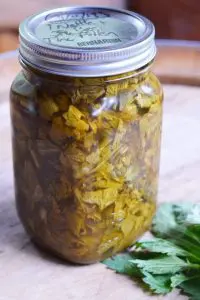How to make herbal tinctures using the folk method
You’ll need:
- Dried or fresh plant material
- Vodka with at least 40% alcohol for dried herbs or 95% alcohol for fresh herbs
- A wide mouth quart canning jar
- A stainless steel funnel
- A stainless steel strainer
- A cloth for pressing out the herbs or a potato ricer
Method:
- Wash and sanitize your equipment.
- Place your chosen herb in the Mason jar. If you are using dried herbs fill the jar half full. The dried herbs will absorb the alcohol and swell in the jar. If you are using fresh herbs, fill the jar completely with the herbs, then cover the herbs with alcohol.
- Use a chopstick to displace any air bubbles. Add more alcohol if necessary to fully cover the herbs.
- Cap tightly and label the jar with the contents and the date. Don’t forget to label, in a month you may not remember what you put in the jar and it will look entirely different.
- Every day or as often as you think of it, shake the jar to evenly distribute the herb in the alcohol.
- After 4 to 6 weeks your tinctures are ready to strain.
To strain the herb, line a fine mesh sieve with a cloth. Place the sieve over a glass bowl to catch the liquid. Once most of the tincture has dripped through the cloth into the bowl, twist up the cloth to squeeze out as much tincture as possible. Alternatively, you can press the plant material in a potato ricer to get the last drops of good medicine out of the plant material.
Pour the tincture into colored glass bottles. Label and store in a cool, dry, dark cupboard. Tinctures have an indefinite shelf life if made with high percentage alcohol.
If you can only get 40% alcohol, you can still use fresh herbs. However, you will want to make sure there is no water or dew on the leaves after rinsing them, and they should be slightly wilted. The tincture will still be stable, but may not last as long as a higher alcohol percentage tincture. You will also want to watch fresh herb tinctures closer than dried herb tinctures, to make sure the herbs stay under the alcohol. If herbs float, there is a slim chance they could mold (more of a worry with oil infusions, though).
PrintHow to make an alcohol based tincture
Ingredients
- Dried or fresh plant material
- Vodka with at least 40% alcohol for dried herbs or 95% alcohol for fresh herbs
- A wide mouth quart canning jar
- A stainless steel funnel
- A stainless steel strainer
- A cloth for pressing out the herbs or a potato ricer
Instructions
- Wash and sanitize your equipment.
- Place your chosen herb in the Mason jar. If you are using dried herbs fill the jar half full. The dried herbs will absorb the alcohol and swell in the jar. If you are using fresh herbs, fill the jar completely with the herbs, then cover the herbs with alcohol.
- Use a chopstick to displace any air bubbles. Add more alcohol if necessary to fully cover the herbs.
- Cap tightly and label the jar with the contents and the date. Don’t forget to label, in a month you may not remember what you put in the jar and it will look entirely different.
- Every day or as often as you think of it, shake the jar to evenly distribute the herb in the alcohol.
- After 4 to 6 weeks your tinctures are ready to strain.


Making tincture’s? May I use Apple Cider Vinegar, Vegetable Glycerin? Does it always have to be alcohol?
Absolutely you can use vinegar or a glycerin. You do get different constituents from the herbs when using vinegar or glycerin. And the shelf life is about 1 year for these compared to many years for alcohol based tinctures. Possibly tea is the best alternative to alcohol because it dissolves more of the herbal constituents than the acid of vinegar, or than glycerin. But of course, tea is not stable at room temperature and dried herb have a shorter shelf life than an alcohol tincture.
You can use glycerin or apple cider vinegar but it will pull from the herbs different constituents than the alcohol. Would it be better for your purposes to leave it as a dried herb and use it for tea?